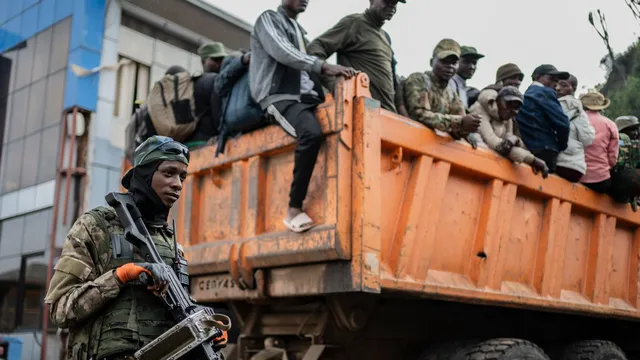
M23 rebels and SADC troops reach ceasefire amid ongoing eastern Congo conflict
2025-03-28 18:58- M23 rebels declared a ceasefire agreement with SADC peacekeepers amid ongoing unrest.
- The ceasefire follows the SADC announcement of troop withdrawals from eastern Congo.
- The agreement reflects a shift in strategy towards dialogue, with M23 criticizing Congolese troop actions.
Express your sentiment!
Insights
The M23 rebels, who have been exerting control over significant regions in eastern Congo, declared a ceasefire on a Friday, following intense skirmishes with the Congolese government forces. Meanwhile, peacekeepers from the South African Development Community, known as SADC, disclosed their decision to withdraw troops, marking a strategic shift in the ongoing conflict in the area. This ceasefire was announced even while the M23 faction continued to engage in hostilities against government forces, illustrating the turbulent dynamics in the region, where various armed groups vie for power and resources. The SADC mission, comprising troops from South Africa, Malawi, and Tanzania, had been deployed to help stabilize the mineral-rich region, which has been plagued by violence and unrest for decades. However, despite the presence of these peacekeepers, M23 rebels, allegedly backed by Rwandan forces, have claimed substantial territory, including important urban centers such as Goma and Bukavu, which they took control of in recent months. Over the past few weeks, the M23's advancement has resulted in numerous casualties, including the deaths of several peacekeepers, and has led to deteriorating public support for the SADC intervention. In light of the escalating violence and the challenges faced by SADC forces, the withdrawal was announced earlier in the month. Despite this withdrawal, the M23's spokesman, Lawrence Kanyuka, emphasized the need for dialogue and political resolutions rather than military confrontations. Kanyuka's comments highlight a significant shift in focus, calling the ceasefire a historic event that underscores the necessity of dialogue moving forward. He urged the SADC mission to mediate with the Congolese authorities to ensure that peace efforts are respected to avert further conflict. The humanitarian situation in eastern Congo has reached critical levels, with over 7 million individuals displaced due to ongoing fighting between numerous factions, including the Congolese military, foreign mercenaries, and various armed groups. Alongside M23, accusations against Rwanda for supporting this rebel group have exacerbated tensions within the region. The timeline of these events illustrates a complex interplay of local and international dynamics, pointing to the profound challenges that lie ahead in resolving the ongoing crises in eastern Congo.
Contexts
The conflict in eastern Congo, particularly in the Democratic Republic of the Congo (DRC), has its roots in a combination of historical, political, and social factors that have evolved over decades. The region is rich in natural resources, which has led to both international interest and significant internal strife. The tensions began to surface significantly after the Rwandan Genocide in 1994, when millions of refugees, including many perpetrators of the genocide, crossed into eastern Congo. This influx exacerbated existing ethnic tensions and led to the First Congo War (1996-1997), in which a coalition of forces, backed by Rwanda and Uganda, overthrew dictator Mobutu Sese Seko. However, the overthrow of Mobutu did not bring peace; instead, it paved the way for further conflict, leading to the Second Congo War (1998-2003), which involved multiple African nations and resulted in millions of deaths, primarily due to violence, starvation, and disease. Post-war, the eastern DRC has continued to be plagued by violence, with various armed groups vying for control of resource-rich territories. The complexities of the conflict are compounded by ethnic rivalries, particularly between local communities and immigrant groups, leading to ongoing violence, human rights abuses, and a humanitarian crisis. Despite numerous peace agreements and international interventions, including the presence of United Nations peacekeeping forces, stability has remained elusive. Many areas are still characterized by the power struggles of militias and the continuous exploitation of resources such as gold, coltan, and diamonds, which are often illegally traded to fund these militias. Additionally, the ongoing conflict has led to significant social consequences, including internal displacement and the disruption of essential services such as healthcare and education. Women and children have been particularly vulnerable, experiencing rampant sexual violence used as a weapon of war. International attention has occasionally focused on the situation, such as reports of human rights violations, but sustained, actionable responses from the global community have often been lacking. Efforts to foster peace and reconciliation continue, though they face numerous challenges, including corruption and the lack of effective governance in the region. In conclusion, the history of conflict in eastern Congo serves as a stark reminder of the complexities of human interactions around resource management, ethnic relations, and the long-term impacts of colonial legacies. Addressing these issues requires an understanding that peacebuilding in the region must incorporate not only military and political solutions but also social and economic dimensions. A comprehensive approach that emphasizes the rule of law, respect for human rights, and community engagement is essential for creating a sustainable path towards reconciliation and stability in eastern Congo.